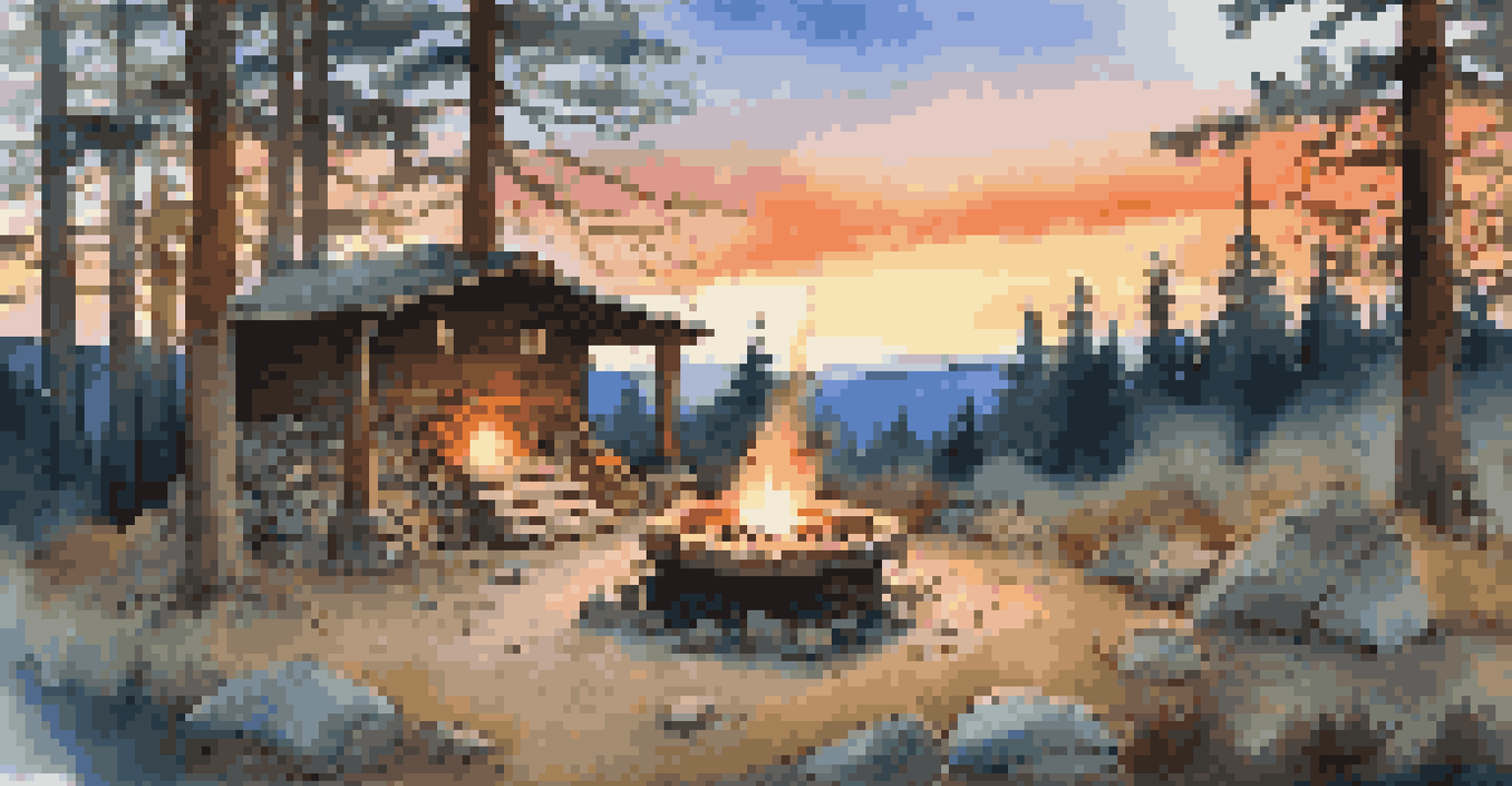Building a Wilderness Survival Shelter: Step-by-Step Guide

Understanding the Importance of a Survival Shelter
In any wilderness survival situation, having a reliable shelter is crucial. It protects you from the elements, whether it's biting cold, heavy rain, or blistering sun. Without a proper shelter, your chances of survival drastically decrease, making this a top priority.
In the wilderness, survival is all about adaptability and making the most of your surroundings.
Think of your shelter as your home base; it provides safety and comfort. Just like you wouldn’t want to spend a night outside without a roof over your head, the same applies in the wild. A good shelter helps maintain your body heat and keeps you dry, which is essential for survival.
Moreover, building a shelter can boost your morale. It gives you a sense of control over your situation and a place to rest your head. After all, being in the wilderness can be overwhelming, and a sturdy shelter can make all the difference.
Choosing the Right Location for Your Shelter
The first step in building a wilderness survival shelter is selecting the right spot. Look for a location that is flat and dry, away from potential hazards like falling branches or flooding streams. A good spot can mean the difference between safety and danger.

Consider the wind direction and natural resources around you. Positioning your shelter against a windbreak, like a hill or dense vegetation, can provide additional protection. Plus, proximity to water and firewood will make your survival efforts much easier.
Shelter is Essential for Survival
A reliable shelter protects you from harsh elements and significantly increases your chances of survival in the wilderness.
Lastly, be mindful of wildlife. Avoid areas with signs of animal activity or nests. You want to feel secure in your shelter, not like you’re sharing it with unintended roommates!
Gathering Materials for Your Shelter
Once you've found the perfect location, it’s time to gather materials. Look for fallen branches, leaves, and grass, which can be used for the frame and insulation of your shelter. Think of it as gathering ingredients for a recipe; each element plays a key role in your final product.
The best way to predict the future is to create it, especially when it comes to your own survival.
Sturdy branches will form the structure, while lighter materials can be used for insulation and roofing. Don’t forget to consider the size of your shelter; it needs to accommodate you and your gear comfortably. If you're with a group, the shelter must be large enough for everyone.
While you're out collecting materials, take a moment to appreciate your surroundings. Nature has a way of grounding us, and collecting materials can also serve as a meditative practice. Plus, it’s an opportunity to observe the environment, which is essential for survival.
Constructing a Basic Lean-To Shelter
A lean-to shelter is one of the simplest designs you can build in the wilderness. To start, find a sturdy tree or rock to lean your long branches against, creating a slanted roof. This design allows rain to run off and provides a cozy nook for you to settle in.
Next, add smaller branches and foliage to cover the frame. Think of it like putting on a roof and walls; the more layers you add, the better protection you’ll have. Make sure to pack the materials tightly to keep out wind and rain.
Choose a Safe Location Wisely
Selecting a flat, dry spot away from hazards and wildlife is crucial for the safety and comfort of your shelter.
Finally, create a bedding area inside using leaves or pine needles. This will provide cushioning and insulation from the cold ground. It’s your little sanctuary, so make it as comfortable as possible!
Enhancing Your Shelter’s Insulation
Insulation is key to staying warm in your shelter, especially during colder nights. Start by adding a thick layer of leaves, grass, or moss to the roof and walls. This natural insulation traps heat and keeps you cozy inside.
You can also use your own gear for additional warmth. If you have a sleeping bag or extra clothing, place them inside your shelter to create a barrier against the cold air. Think of it as snuggling up in your favorite blanket on a chilly evening.
Don’t forget to check for gaps where cold air might enter. Seal these openings with additional materials to ensure your shelter remains as warm as possible. Every little step you take adds to your comfort and safety.
Creating a Fire Pit Near Your Shelter
Having a fire pit nearby can significantly enhance your survival experience. A fire provides warmth, light, and a means to cook food or purify water. However, it’s essential to build it safely and responsibly. Choose a spot that is a safe distance from your shelter to prevent any accidental fires.
To create a fire pit, clear an area of debris and create a circle using stones to contain the fire. This helps prevent it from spreading and keeps the heat concentrated. Remember, a well-contained fire is both a source of comfort and a tool for survival.
Maintain Your Shelter Regularly
Routine maintenance and repairs are necessary to ensure your shelter remains effective against the elements and wildlife.
Gather firewood in varying sizes; small twigs for kindling and larger logs for sustained burning. This way, you’ll have everything you need to get your fire going. A fire not only keeps you warm but also boosts morale and provides a sense of security in the wilderness.
Maintaining Your Shelter for Optimal Use
Just like any home, your wilderness shelter needs maintenance to stay effective. Regularly check for any damage caused by weather or wildlife. If you notice any gaps or weak spots, make repairs promptly to ensure your safety.
Keep the area around your shelter clean and organized. This not only helps prevent attracting unwanted wildlife but also makes it easier to navigate your space. A tidy shelter promotes a sense of calm and order in what can often feel like a chaotic environment.

Finally, be adaptable! The wilderness can change rapidly, so remain flexible and ready to adjust your shelter or even relocate if necessary. Embracing change is part of the adventure and essential for your survival.